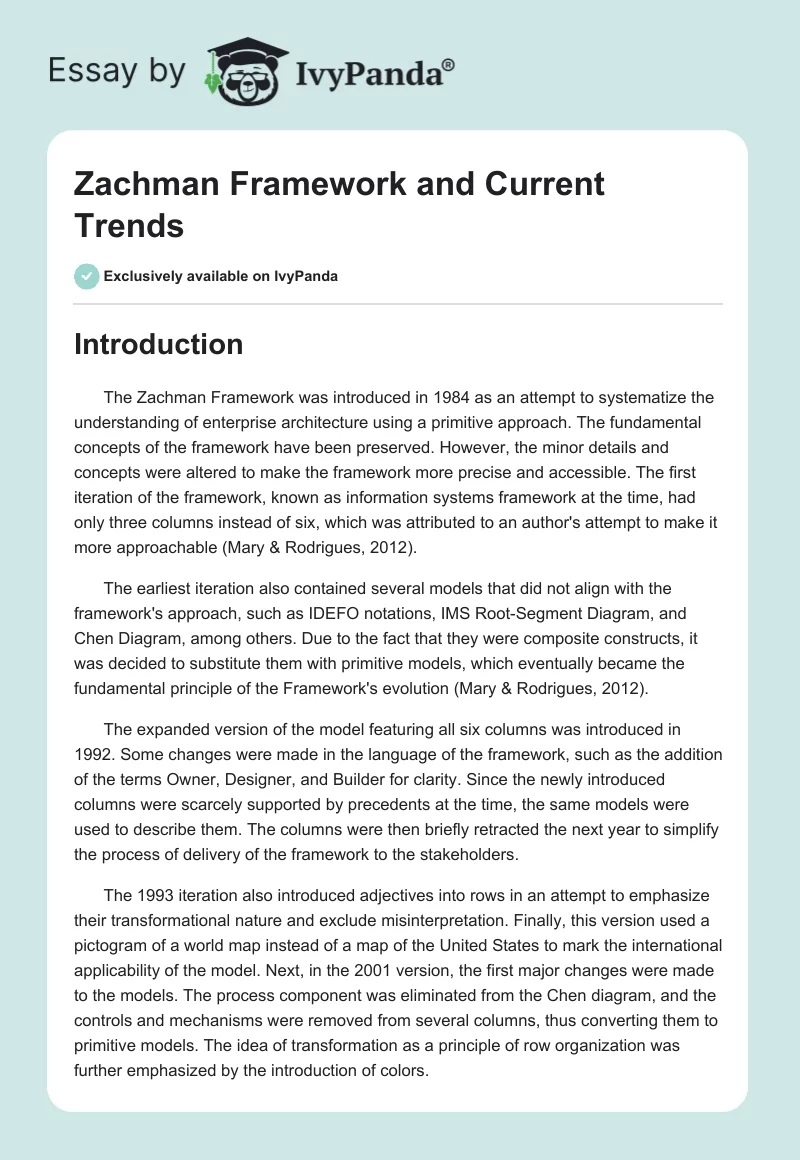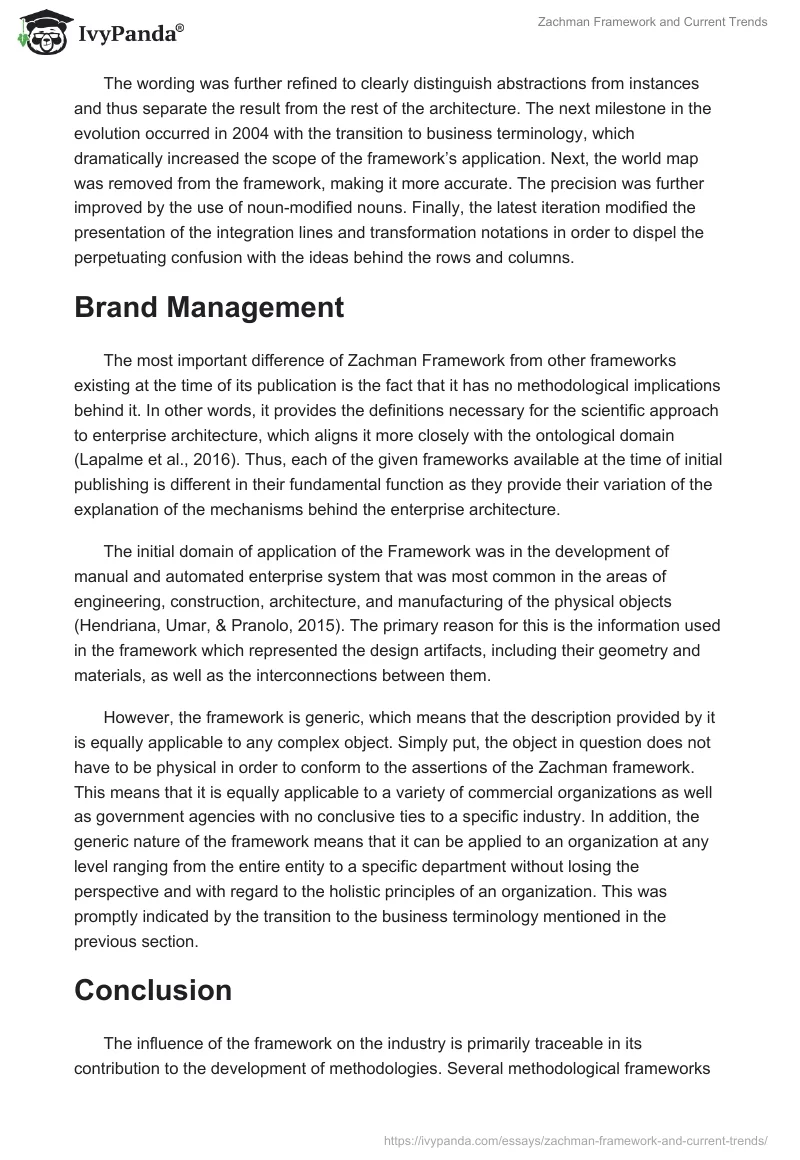Introduction
The Zachman Framework was introduced in 1984 as an attempt to systematize the understanding of enterprise architecture using a primitive approach. The fundamental concepts of the framework have been preserved. However, the minor details and concepts were altered to make the framework more precise and accessible. The first iteration of the framework, known as information systems framework at the time, had only three columns instead of six, which was attributed to an author’s attempt to make it more approachable (Mary & Rodrigues, 2012).
The earliest iteration also contained several models that did not align with the framework’s approach, such as IDEFO notations, IMS Root-Segment Diagram, and Chen Diagram, among others. Due to the fact that they were composite constructs, it was decided to substitute them with primitive models, which eventually became the fundamental principle of the Framework’s evolution (Mary & Rodrigues, 2012).
The expanded version of the model featuring all six columns was introduced in 1992. Some changes were made in the language of the framework, such as the addition of the terms Owner, Designer, and Builder for clarity. Since the newly introduced columns were scarcely supported by precedents at the time, the same models were used to describe them. The columns were then briefly retracted the next year to simplify the process of delivery of the framework to the stakeholders.
The 1993 iteration also introduced adjectives into rows in an attempt to emphasize their transformational nature and exclude misinterpretation. Finally, this version used a pictogram of a world map instead of a map of the United States to mark the international applicability of the model. Next, in the 2001 version, the first major changes were made to the models. The process component was eliminated from the Chen diagram, and the controls and mechanisms were removed from several columns, thus converting them to primitive models. The idea of transformation as a principle of row organization was further emphasized by the introduction of colors.
The wording was further refined to clearly distinguish abstractions from instances and thus separate the result from the rest of the architecture. The next milestone in the evolution occurred in 2004 with the transition to business terminology, which dramatically increased the scope of the framework’s application. Next, the world map was removed from the framework, making it more accurate. The precision was further improved by the use of noun-modified nouns. Finally, the latest iteration modified the presentation of the integration lines and transformation notations in order to dispel the perpetuating confusion with the ideas behind the rows and columns.
Brand Management
The most important difference of Zachman Framework from other frameworks existing at the time of its publication is the fact that it has no methodological implications behind it. In other words, it provides the definitions necessary for the scientific approach to enterprise architecture, which aligns it more closely with the ontological domain (Lapalme et al., 2016). Thus, each of the given frameworks available at the time of initial publishing is different in their fundamental function as they provide their variation of the explanation of the mechanisms behind the enterprise architecture.
The initial domain of application of the Framework was in the development of manual and automated enterprise system that was most common in the areas of engineering, construction, architecture, and manufacturing of the physical objects (Hendriana, Umar, & Pranolo, 2015). The primary reason for this is the information used in the framework which represented the design artifacts, including their geometry and materials, as well as the interconnections between them.
However, the framework is generic, which means that the description provided by it is equally applicable to any complex object. Simply put, the object in question does not have to be physical in order to conform to the assertions of the Zachman framework. This means that it is equally applicable to a variety of commercial organizations as well as government agencies with no conclusive ties to a specific industry. In addition, the generic nature of the framework means that it can be applied to an organization at any level ranging from the entire entity to a specific department without losing the perspective and with regard to the holistic principles of an organization. This was promptly indicated by the transition to the business terminology mentioned in the previous section.
Conclusion
The influence of the framework on the industry is primarily traceable in its contribution to the development of methodologies. Several methodological frameworks were derived from it in an attempt to apply the ontology to specific domains. The most prominent examples are The Open Group Architecture Framework (TOGAF), the Federal Enterprise Architecture Framework (FEAF), and the Department of Defense Architecture Framework (DoDAF) (Cameron & McMillan, 2013).
Each of these frameworks provides a more specific viewpoint with concrete definitions of resulting products and, in some cases, the aspects specific to the field and specific methodologies. All of the latter frameworks also incorporate recommendations on the development of enterprise architecture pertinent to their respective field (in contrast to Zachman Framework which provides only generic definitions).
Therefore, the Zachman Framework serves as a normalized classification system that is meant to be utilized in a given area for the development of the industry-specific recommendations, guidelines, and methodologies with a high degree of precision and specificity.
References
Cameron, B. H., & McMillan, E. (2013). Analyzing the current trends in enterprise architecture frameworks. Journal of Enterprise Architecture, 9(1), 60-71.
Hendriana, Y., Umar, R., & Pranolo, A. (2015). Modelling and design E-Commerce SMI sector using Zachman Framework. International Journal of Computer Science and Information Security, 13(8), 9-14.
Lapalme, J., Gerber, A., Van der Merwe, A., Zachman, J., De Vries, M., & Hinkelmann, K. (2016). Exploring the future of enterprise architecture: A Zachman perspective. Computers in Industry, 79, 103-113.
Mary, S. R., & Rodrigues, P. (2012). Software architecture-evolution and evaluation. International Journal of Advanced Computer Science and Applications, 3(8), 82-88.


